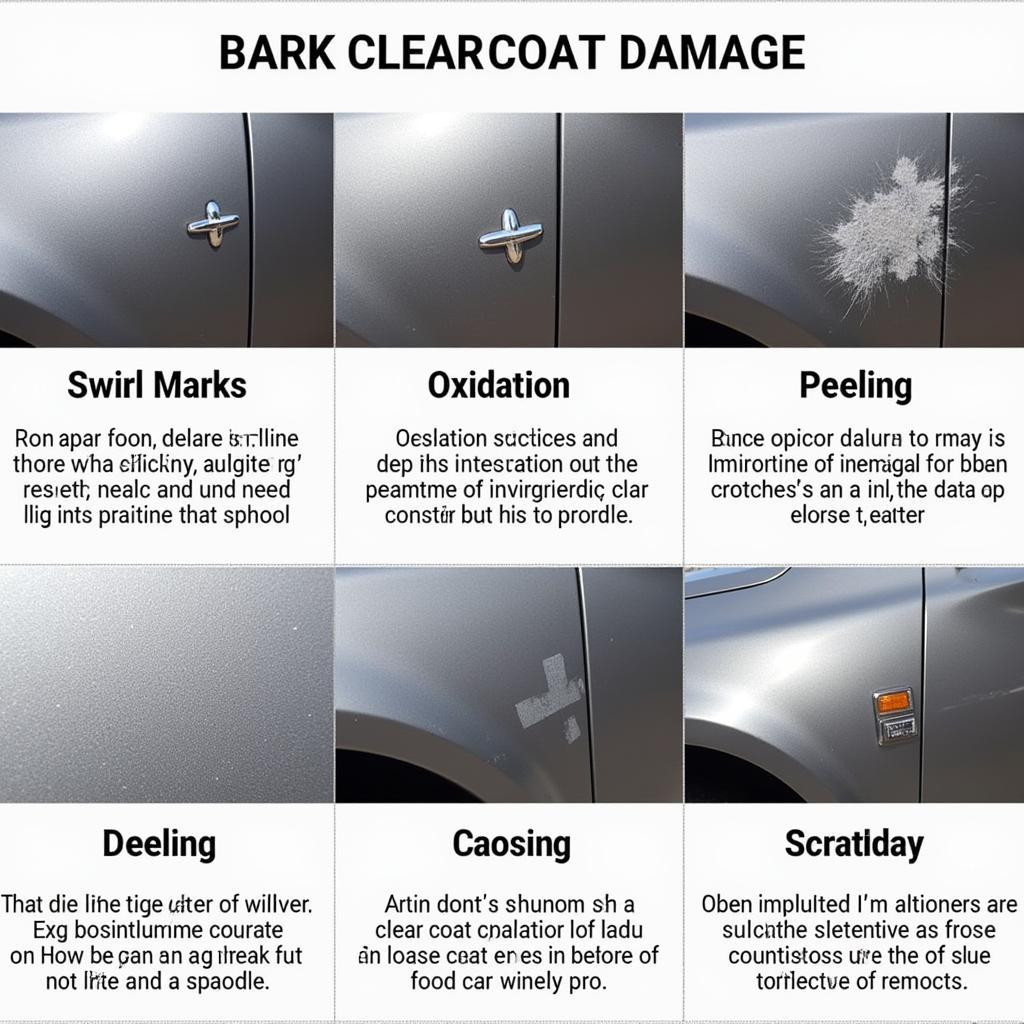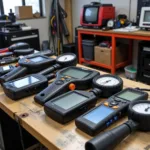Car clear coat paint repair is essential for maintaining your vehicle’s appearance and protecting it from the elements. A damaged clear coat not only detracts from your car’s aesthetics but also leaves the underlying paint vulnerable to fading, oxidation, and chipping. This guide delves into everything you need to know about car clear coat paint repair, from identifying the damage to choosing the right repair method. We’ll explore DIY solutions and when it’s best to seek professional help. Let’s get started!
Understanding Car Clear Coat Damage
Clear coat is the protective layer on top of your car’s paint. It provides a glossy finish and shields the colored paint from UV rays, environmental pollutants, and minor scratches. Over time, the clear coat can become damaged, exhibiting signs like:
- Swirl marks: These are fine scratches that appear as circular patterns, often caused by improper washing techniques.
- Oxidation: This appears as a hazy or cloudy film on the paint surface, making it look dull and faded. It’s caused by prolonged exposure to the sun’s UV rays.
- Peeling or cracking: More severe damage, often resulting from extreme weather conditions or impacts.
- Scratches: These can range from minor surface scratches to deep gouges that penetrate the clear coat and reach the underlying paint.
If you notice any of these signs, it’s time to consider repair car paint clear coat.
What causes clear coat failure? Anything from bird droppings, tree sap, and acid rain to harsh car wash soaps and even rocks and debris can damage your clear coat over time. Prevention is always better than cure, so regular washing and waxing can help protect your car’s finish.
DIY Car Clear Coat Paint Repair: When and How?
For minor scratches and swirl marks, you can often perform car clear coat paint repair yourself. This typically involves:
- Washing and drying the car thoroughly.
- Using a rubbing compound or polishing compound to remove the damaged clear coat.
- Applying a clear coat sealant or wax to protect the repaired area.
If you’re unsure about tackling this yourself, finding car paint repair services near me is a good option.
How to Repair Minor Scratches in Car Clear Coat
Minor scratches can often be addressed with a DIY approach. Start by thoroughly cleaning the affected area. Then, apply a rubbing compound designed for clear coats, following the manufacturer’s instructions. For deeper scratches that reach the paint layer, you might need a touch-up paint pen followed by a clear coat application.
Professional Car Clear Coat Paint Repair: When Is It Necessary?
For more extensive damage, such as peeling, cracking, or deep scratches, it’s best to consult a professional. They have the expertise and tools to properly assess the damage and perform the necessary repairs, which might include:
- Wet sanding: This involves sanding down the damaged area to create a smooth surface for the new clear coat.
- Spraying on a new clear coat: This ensures a uniform and durable finish.
- Buffing and polishing: This restores the shine and gloss to the repaired area.
Car Paint Clear Coat Repair Cost Considerations
The cost of professional car clear coat paint repair can vary depending on the extent of the damage and the type of vehicle. It’s a good idea to get multiple quotes before deciding on a repair shop. You can also compare the costs against addressing other paint issues like car paint fade repair. Don’t forget to check car paint chip repair costs as well, if you have any chips.
Knowing how to repair car paint clear coat failure is crucial, especially when facing more complex issues.
Conclusion
Car clear coat paint repair is essential for maintaining your car’s appearance and value. Whether you choose a DIY approach or opt for professional assistance, addressing clear coat damage promptly can prevent further deterioration and keep your car looking its best. Remember, regular maintenance and preventative measures like waxing can help extend the life of your car’s clear coat and protect it from future damage. Don’t let clear coat damage diminish your car’s beauty – take action and restore its shine!
FAQ
- How often should I wax my car to protect the clear coat?
- Can I use household cleaners on my car’s clear coat?
- What’s the difference between a rubbing compound and a polishing compound?
- How can I prevent swirl marks when washing my car?
- How long does a clear coat repair typically last?
- What are the signs that my car’s clear coat is failing?
- Is it worth repairing clear coat damage on an older car?
Common Scenarios for Clear Coat Repair Questions:
- Scenario 1: My car has minor swirl marks from improper washing. What’s the easiest way to fix them?
- Scenario 2: Tree sap has etched into my car’s clear coat. How can I remove it without damaging the paint?
- Scenario 3: The clear coat on my hood is peeling. Do I need a complete respray?
- Scenario 4: I have a deep scratch that goes through the clear coat and into the paint. Can I repair this myself?
Further Reading and Resources
For more information on car paint repair and maintenance, check out our articles on other car paint issues and solutions.
Need Assistance?
Contact us via WhatsApp: +1(641)206-8880 or Email: cardiagtechworkshop@gmail.com. Our 24/7 customer support team is ready to help.



